#anonymous Netherlandish painter
Text
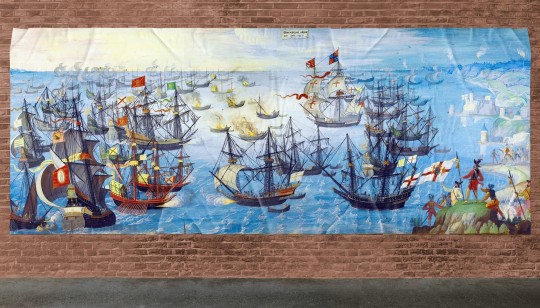
Monogrammist, The Spanish Armada Off The South Coast Of England
#Monogrammist#powerpoint slides#anonymous Netherlandish painter#Pieter Bruegel the Elder#Spanish armada
0 notes
Text

Adriaen van Overbeke - The Adoration of the Magi -
Adriaen van Overbeke, Adrian van Overbeck and Adriaen van Overbeke (fl 1508 – 1529) was a Flemish Renaissance painter in the style of Antwerp Mannerism. He operated a large workshop with an important output of altarpieces, which were mainly exported to Northern France, the Rhineland and Westphalia. His known works were predominantly polychromed wooden altarpieces with painted shutters, which were created through a collaboration between painters and sculptors.
Van Overbeke was the head of a large workshop, which employed many assistants. He further developed collaborations with other Antwerp workshops including of painters and sculptors. He appeared therefore in contemporary contracts both as a principal as well as a subcontractor. With the increasing success of his business, he gradually participated less in the execution of works and he became an entrepreneur who relied on workshop assistants and other workshops to create the altarpieces.
Models in his workshop were used to create a workshop style. The workshop style also included compliance with certain conventions regarding the palette which remained very similar over a period of about 15 years. Blue and red dominate in strong tones. Continuity of the workshop style was also achieved through a rational image design. The figures were brought to the foreground and often recurring groups of figures must have been based on workshop templates. The design of various compositions relied on prints of Albrecht Dürer. The adoption of a workshop style explains why it is difficult to attribute works to him on style-critical grounds. Van Overbeke himself is believed to have spent a lot of his time traveling abroad to meet with his patrons. Unlike other workshops in Antwerp, the van Overbeke workshop is not known for serially produced altarpieces of the passion of Christ or the life of the Virgin Mary. Typical traits of van Overbeke's style are the tall figures with somewhat elongated faces and small eyes, broad faces with the hanging angle of the mouth and sunken eyes, and thin hands with long fingers. The landscapes typically contain rock formations.
Van Overbeke is considered a representative of Antwerp Mannerism. The term Antwerp Mannerism was coined by Friedländer in the early 20th century to refer to a transitory phase in Netherlandish art from the late Gothic to works inspired by the Italian Renaissance. The terms "Manier" and "Manierist" were used by Friedländer to refer to the original even unusual motifs in the body of work categorized under this style. The terms carried a pejorative connotation as these works were regarded as inferior to work produced by Pieter Coecke van Aelst, Quentin Matsys and other contemporaries. The style of these works was often extravagant. This was reflected in how the folds of the flamboyant and exotic clothes worn by the figures defied gravity. These figures were usually depicted in agitated poses amidst architectural ruins. The earlier works included Gothic architecture but in later works Renaissance structures became prevalent. The paintings appear to combine Early Netherlandish and Northern Renaissance styles, and incorporate both Flemish and Italian traditions into the same compositions. Most of the artists of Antwerp Mannerism have remained anonymous and only some of the artists have been identified. They include Jan de Beer and the Master of 1518 (possibly Jan Mertens or Jan van Dornicke). Adriaen van Overbeke himself was only recently identified with the anonymous master who was given the notname 'Master of the Crucifixion of Antwerp' by Friedländer.
19 notes
·
View notes
Photo
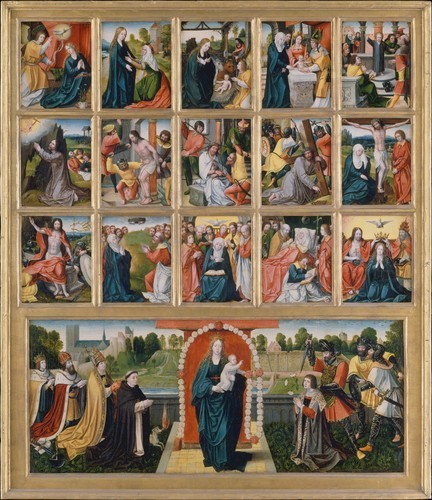
The Fifteen Mysteries and the Virgin of the Rosary, Netherlandish Painter , ca. 1515–20, European Paintings
Anonymous Bequest, 1984
Size: (a) 9 7/8 x 21 in. (25.1 x 53.3 cm); (b–p) each 5 x 4 1/8 in. (12.7 x 10.5 cm)
Medium: Oil on wood
https://www.metmuseum.org/art/collection/search/437216
5 notes
·
View notes
Text
Italian with a French Accent (Part II): Attributing the Illuminations of Lewis E 207
Fifty-two discoveries from the BiblioPhilly project, No. 42/52
Prayer Book, Philadelphia, Free Library of Philadelphia, Lewis E 207, fol. 1r (miniature of the Presentation in the Temple); Gian Giacomo Trivulzio in Prayer before Saint Jerome, Trivulzio Hours, Madrid, Biblioteca Lazaro Galdiano, inv. 15454, fol. 16v (miniature of Gian Giacomo Trivulzio in Prayer before Saint Jerome)
Back in October, I posted about the Free Library of Philadelphia’s Lewis E 207, an unusual northern Italian prayer book that is prefaced by four abbreviated prayers from the Hours of the Virgin, each illustrated by a miniature executed in a naive but charming style and surrounded by illusionistic flower stems that seem to be threaded through the page. In conducting further research on this item for the Making the Renaissance Manuscript: Discoveries from Philadelphia Libraries exhibition, I contacted Professor Pier Luigi Mulas of the University of Pavia, an expert in Lombard illumination of the fifteenth and sixteenth centuries, who very helpfully suggested some interesting stylistic comparisons and the potential identity of the artist responsible for the images and the borders.
According to Professor Mulas, these illustrations can be attributed to an anonymous illuminator responsible for choir books V-2 and DR-3 at the Biblioteca Capitolare of Busto Arsizio, northwest of Milan.1 Though these large volumes have not been digitized, comparisons with a few of the published photos of details from this set of liturgical books are very convincing. In fact, they all but confirm that the illuminations in the Philadelphia manuscript are the work of the same artist. Note, for example, the impish, upward-looking figures of the Apostles in the Busto Arsizio Ascension and how they compare to those in the foreground of the miniature on folio 3r of our manuscript. The fuzzy grey hairstyles and golden curls are one-and-the-same across both manuscripts, as are the shortened limbs and highly simplified, gesticulating hands. While the color scheme appears different, this may be due to the quality of the available photo reproductions of the Busto Arsizio manuscripts.
Busto Arsizio, Biblioteca Capitolare, DR-3, fol. 66v (detail of historiated initial of the Ascension); Lewis E 207, fol. 3r (detail of miniature of the Assumption of the Virgin)
The most innovative aspect of Lewis E 207, however, consists of the illusionistically painted sprigs of violas, carnations, and other flowers surrounding the four prefatory miniatures, painted so as to appear threaded through cuts in the parchment. As discussed in the earlier post, this clever visual device is closely associated not with Italian but with Netherlandish manuscript illumination, particularly work from the so-called Ghent-Bruges school. For example, a Book of Hours with decorations by associates of the the Master of Mary of Burgundy, now in Cracow, has broadly similar sprigs of flora in its margins, though it has the added virtuoso twist of showing the corresponding portions of the stems peeking through the reverse sides of the relevant pages, a true feat of visual whit!
Master of the Berlin Prayer Book H 78 B 12 and Ghent Associates, Pierced strewn flower page (with corresponding portions of stems depicted on reverse) from a Book of Hours, ca. 1483. Krakow, Czartoryski Library, Ms. 3025 I, pp. 71 and 72.
The Philadelphia manuscript lacks such a masterly touch, but it is perhaps even more remarkable given that it shows an Italian artist experimenting with such effects, perhaps inspired by fashionable exemplars hailing from north of the Alps. As suggested by Professor Mulas, the four flower margins in our manuscript exhibit close parallels to a much more extensive set of floral borders in the Hours of Gian Giacomo Trivulzio, today at the Museo Lázaro Galdiano in Madrid.2 Trivulzio (1440/41–1518) was an important Milanese condottiere who served the French in their campaigns in Lombardy, a fact which might explain the “northern” flavor of his Book of Hours.
Madrid, Biblioteca Lazaro Galdiano, inv. 15454, fol. 21v (miniature of Saint Luke); fol. 30r (miniature of the Virgin and Child with John the Baptist)
The artist who painted the very fine miniatures (though not the borders) in the Madrid book, tentatively identified as Percivalle de’ Negri, is evidently quite distinct from the painter of our four main miniatures (and two historiated initials). In any case, de’ Negri was dead by 1505, so he is not a candidate for the illustration of Lewis E 207’s borders, as the Philadelphia book would seem to date from around 1510. Nevertheless, the floral borders in the Madrid and Philadelphia manuscripts appear to be by a single hand: their sheer uniqueness, not to mention an identical palette and synonymous way of dealing with the bottom of the stems bears this out. So was there a specialist painter of floral borders in the Northern manner active in Milan in the first two decades of the sixteenth century, or is the painter of Lewis E 207’s miniatures responsible for all these borders as well, working as a peripheral assistant in the case of the Madrid hours? Looking closely at some of the published details from the Busto Arsizio choir books (including the marginal sprays extending from the left-hand side of the Acension initial shown above), it would seem that the illuminator is one and the same as our border illustrator. Flowers, very similar to those in the margins of Lewis E 207, grow out of the historiated initials but also find themselves in the centers of smaller, more modestly-decorated initials. The new evidence gleaned from the Free Library manuscript allows us to better understand this idiosyncratic artist—equally proficient in border designs, initials, and miniatures—active at a tumultuous juncture in Italian history.
Busto Arsizio, Biblioteca Capitolare, V-2, fol. 5v (detail of a decorated initial); fol. 2r (detail of historiated initial with King David)
from WordPress http://bibliophilly.pacscl.org/italian-with-a-french-accent-part-ii-attributing-the-illuminations-of-lewis-e-207/
6 notes
·
View notes
Text
Art History Reader: The Renaissance

Renaissance is a French word meaning ‘rebirth’, and in this case, it refers to the rebirth of the ideas and culture of Classical Greek and Roman civilization. The Renaissance took place in Western Europe and marked the beginning of the end of the Middle Ages. Basically, Europeans were growing more and more tired of going medieval on each other.
Most European Medieval art was created by anonymous craftsmen in the service of the Catholic Church. A lot of it was meant to instill the fear of God in the average, illiterate viewer. But things changed in the Renaissance. The world became larger as global trade increased, cities grew, and patrons other than the Church could suddenly afford to commission art. At the same time, humankind's relationship to God, the world, and the Cosmos was being redefined. Whereas Medieval man toiled in the fields of his feudal lord and lived in terror of the Day of Judgment, a new movement called Humanism promoted more "earthly" pursuits such as education, ethical living, and individual ability. This is why we know the names of artists from the Renaissance. They finally started getting some of the glory for their work.
The Renaissance began in the fourteenth century, and Florence, Italy was its hotbed. Urban intellectuals studied the Roman ruins around them, rediscovered Classical Latin texts, and modeled their own poetry and art after the balance and beauty of that of their Classical forebears. At the same time, the nature of the physical world became a subject worthy of study, and artists became more interested in accurately depicting the world around them, leading to the discovery of single-point-perspective.
The Northern European Renaissance was fueled by some of the same intellectual ideas as the Southern, but was distinctive for the rise in the use of oil paint, which allowed artists to create meticulously detailed, realistic images. Furthermore, the invention of the printing press in Germany allowed books and images to be disseminated far and wide, so when the Reformation came along, new ideas about art and religion were able to spread easily. Distrust of idealized religious imagery would end up leading to an increase in images depicting modern life, often with a moralizing tone, in Germany and the Low Countries.
For this class, we will study the Northern European Renaissance figures such as Gutenberg, Dürer, Holbein and van Eyck, and the Southern European Renaissance artists such as Giotto, the Teenage Mutant Ninja Turtles (Leonardo, Donatello, Michelangelo and Raphael), Brunelleschi, and Fra Angelico. Many of these artists were not just artists, but also writers, politicians, scientists and philosophers, and they helped usher in the beginning of the age of enlightenment and the development of the scientific method.
List of Key Renaissance artists
Northern Renaissance:
Jan van Eyck - Hailed as the inventor of oil painting
Robert Campin - the "Master of Flémalle"
Rogier van der Weyden - Early Netherlandish master
Hans Holbein the Younger - Court artist to Henry VIII
Hieronymus Bosch - Painter of the fantastic and ironic
Pieter Bruegel the Elder - Cynic and Humanist Painter
Martin Schongauer - German Engraver; see more of his work here.
Albrecht Dürer - Painter, Businessman, and one of the first artists to use typography as an art form
Check out his typography book, "Of the Shaping of the Letter," here.
Southern Renaissance:
Giotto - The first "Renaissance Man"
Fra Angelico - A Dominican monk and painter
Leonardo da Vinci - An all around over-achiever
Donatello - A prolific sculptor
Michelangelo - Sculptor, painter, architect, poet
Raphael - Star boy of the Renaissance
Brunelleschi - A goldsmith turned architect and Renaissance poster-child
Sandro Botticelli - Painter of myths
This reader is part of a larger series of introductory texts about art and art history. Each has been written under the direction of Rick Love. This reader was co-authored by Jeannette Sturman.
By: Rick Love
11 notes
·
View notes
Text
19 Secrets You Will Not Want To Know About 19th Century Landscape Paintings | 19th century landscape paintings
19 Secrets You Will Not Want To Know About 19th Century Landscape Paintings | 19th century landscape paintings – 16th century landscape paintings
| Delightful to help my own blog, on this period I will demonstrate about keyword. And today, this is the primary photograph:
Landscape By Probably Luini Bernardino 19th Century Fresco Fine art … – 16th century landscape paintings | 16th century landscape paintings
What about picture preceding? is usually of which awesome???. if you’re more dedicated so, I’l m show you a number of impression once more beneath:
So, if you wish to acquire all of these fantastic pics about (19 Secrets You Will Not Want To Know About 19th Century Landscape Paintings | 19th century landscape paintings), press save button to save the graphics to your computer. They are available for transfer, if you appreciate and wish to obtain it, simply click save logo in the web page, and it will be immediately downloaded to your notebook computer.} As a final point if you’d like to get unique and latest graphic related to (19 Secrets You Will Not Want To Know About 19th Century Landscape Paintings | 19th century landscape paintings), please follow us on google plus or bookmark the site, we try our best to provide daily up-date with all new and fresh pics. We do hope you enjoy staying right here. For many upgrades and recent news about (19 Secrets You Will Not Want To Know About 19th Century Landscape Paintings | 19th century landscape paintings) images, please kindly follow us on twitter, path, Instagram and google plus, or you mark this page on bookmark section, We attempt to offer you up-date periodically with all new and fresh graphics, love your browsing, and find the right for you.
Thanks for visiting our website, contentabove (19 Secrets You Will Not Want To Know About 19th Century Landscape Paintings | 19th century landscape paintings) published . Today we’re delighted to announce that we have discovered an awfullyinteresting topicto be discussed, that is (19 Secrets You Will Not Want To Know About 19th Century Landscape Paintings | 19th century landscape paintings) Most people looking for information about(19 Secrets You Will Not Want To Know About 19th Century Landscape Paintings | 19th century landscape paintings) and of course one of these is you, is not it?
Anonymous with seal reading “Bunsei,” Painting of Palaces in a … – 16th century landscape paintings | 16th century landscape paintings
Italian Oil on Canvas, "Landscape with Ruins and Herds … – 16th century landscape paintings | 16th century landscape paintings
Sunrise over Yellow Mountain – Huangshan – Anhui – China – 16th century landscape paintings | 16th century landscape paintings
Exhibitions > 19 > Dutch Landscapes: Paintings … – 16th century landscape paintings
‘ alt=’The Bowes Museum > Exhibitions > 19 > Dutch Landscapes: Paintings … – 16th century landscape paintings
‘ />The Bowes Museum > Exhibitions > 19 > Dutch Landscapes: Paintings … – 16th century landscape paintings | 16th century landscape paintings
File:Alexander Keirincx – Richmond Castle, Yorkshire … – 16th century landscape paintings | 16th century landscape paintings
Canadian Art Landscape – Galerie Q | Art Galerie Blog – 16th century landscape paintings | 16th century landscape paintings
Alison Smith, 'The Sublime in Crisis: Landscape Painting … – 16th century landscape paintings | 16th century landscape paintings
Netherlandish Painters Active in Britain in the 19th and 19th … – 16th century landscape paintings | 16th century landscape paintings
Theobald Michau (1676-1765) Flemish Painter ~ Artists and Art – 16th century landscape paintings | 16th century landscape paintings
Landscape painting – Wikipedia – 16th century landscape paintings | 16th century landscape paintings
Roman School, 19th Century | A southern landscape with antique ruins … – 16th century landscape paintings | 16th century landscape paintings
Mauritshuis acquires key work by influential 16th-century … – 16th century landscape paintings | 16th century landscape paintings
An 18th Century Oil on Oak Panel in the 16th century Italian – 16th century landscape paintings | 16th century landscape paintings
Pavlovsk Palace. Павловский Дворец. – 16th century landscape paintings | 16th century landscape paintings
Landscape with Mercury and Argus (Getty Museum) – 16th century landscape paintings | 16th century landscape paintings
Jacob van Ruisdael (Haarlem c. 1628-Amsterdam 1682 … – 16th century landscape paintings | 16th century landscape paintings
The State Hermitage Museum St. Petersburg Russia | Shaun's … – 16th century landscape paintings | 16th century landscape paintings
Art Collection – Staten Island Museum – 16th century landscape paintings | 16th century landscape paintings
from WordPress https://landscapeusa.club/19-secrets-you-will-not-want-to-know-about-19th-century-landscape-paintings-19th-century-landscape-paintings/
0 notes
Video
Petrus Christus: A collection of 32 paintings (HD) [Nothern Renaissance]
Petrus Christus: A collection of 32 paintings (HD) [Nothern Renaissance]
#Petrus_Christus
- Born: c.1410; Baarle-Hertog, Belgium
- Died: c.1475; Bruges, Belgium
- Nationality: Flemish
- Art Movement: Northern Renaissance
- Painting School: Dutch School
- Genre: portrait
- Field: painting
- Influenced by: Jan van Eyck
- Influenced on: Hugo van der Goes
- Teachers: Jan van Eyck
Wikipedia: en.wikipedia.org/wiki/Petrus_Christus
_________
Petrus Christus (c. 1410/1420 – 1475/1476) was an Early Netherlandish painter active in Bruges from 1444, where, along with Hans Memling, he became the leading painter after the death of Jan van Eyck. He was influenced by van Eyck and Rogier van der Weyden and is noted for his innovations with linear perspective and a meticulous technique which seems derived from miniatures and manuscript illumination. Today, some 30 works are confidently attributed to him.[1] The best-known include the 1446 Portrait of a Carthusian and c. 1470 Berlin Portrait of a Young Girl, both are highly innovative in presentation of the figure against detailed, rather than flat, backgrounds.
Christus was an anonymous figure for centuries, his importance not established until the work of modern art historians. Giorgio Vasari barely mentions him in his biographies of painters, written in the Renaissance, and near contemporary records merely list him amongst many others. In the early to mid-nineteenth century, Gustav Waagen (who identified him in Francophile language as "Pierre Christophsen") and Johann David Passavant were important in establishing Christus's biographical details and in attributing works to him.
Christus was born in Baarle, near Antwerp and Breda. Long considered a student of and successor to Jan van Eyck, his paintings have sometimes been confused with those of van Eyck.[3] At the death of van Eyck in 1441, it is thought that Christus took over his master's workshop. Christus purchased his Bruges citizenship in 1444, exactly three years after van Eyck's death,[4] taking advantage of a decree set down by Philip the Good allowing in men indebted to him after the Bruges Revolt of 1436–38. Had he been an active pupil in van Eyck's Bruges workshop in 1441, he would have received his citizenship automatically after the customary period of one year and one day.[5] Christus may have been van Eyck's successor in the Bruges school, but perhaps not his pupil. Recent research reveals that Christus, long seen only in his predecessor's light, was an independent painter whose work shows just as much influence from, among others, Dirk Bouts, Robert Campin and Rogier van der Weyden.
---------------------------------
Check out My work here
------------------
#BAROQUE [Post Renaissance Art] : https://www.youtube.com/playlist?list=PLOZVqusZxS_TFGVWRL6nG5V3C9j3h5xnp
#Northern_Renaissance [RENAISSANCE ART] : https://www.youtube.com/playlist?index=1&playnext=1&list=PLOZVqusZxS_RHzh0LcGOpJ30L9CxZAHmf
#Mannerism (Late Renaissance) [RENAISSANCE ART] : https://www.youtube.com/playlist?list=PLOZVqusZxS_R-6z6EiRJoHlqBNULhPdZQ
#HIGH_RENAISSANCE [Renaissance Art]: https://www.youtube.com/playlist?list=PLOZVqusZxS_TAW8yBAWDSpPeV-B4EUnUe
#EARLY_RENAISSANCE [RENAISSANCE ARTS] : https://www.youtube.com/playlist?list=PLOZVqusZxS_Rl5u1xeWi3_hNWVbd99rp8
#PROTO_RENAISSANCE [Renaissance Art] : https://www.youtube.com/playlist?list=PLOZVqusZxS_R6P61q7DOnuZgGGsqw-tN3
#Medieval_Art : https://www.youtube.com/playlist?list=PLOZVqusZxS_T7YNe7cv7fLpg6Hej3NiSh
THE HIGHLIGHT: https://www.youtube.com/playlist?list=PLOZVqusZxS_RMuvIyAIEplral4SxUwJt8
Updating ...
_____
SUBSCRIBE: https://www.youtube.com/channel/UCIuWeUnkfqn_yKlo_RAaoDA
Google+: https://plus.google.com/116866857388773060412
Twitter: https://twitter.com/_NineTv
Facebook: https://www.facebook.com/NineTv.8102/
Contact: [email protected]
Thank you for your support!
:| 9Tv |:
No Arts No Life
© Copyright by 9Tv
0 notes
Photo

The Fifteen Mysteries and the Virgin of the Rosary, Netherlandish Painter , ca. 1515–20, European Paintings
Anonymous Bequest, 1984
Size: (a) 9 7/8 x 21 in. (25.1 x 53.3 cm); (b–p) each 5 x 4 1/8 in. (12.7 x 10.5 cm)
Medium: Oil on wood
https://www.metmuseum.org/art/collection/search/437216
4 notes
·
View notes
Photo
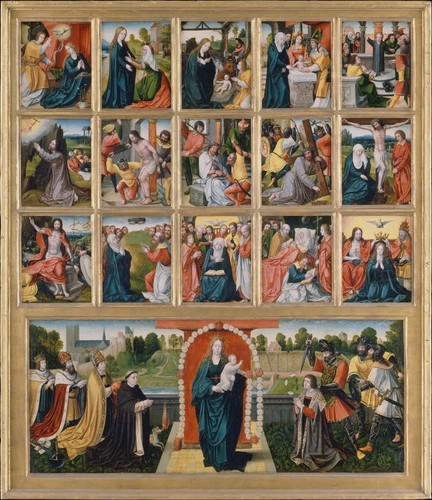
The Fifteen Mysteries and the Virgin of the Rosary by Netherlandish Painter , ca. 1515–20, European Paintings
Anonymous Bequest, 1984 Metropolitan Museum of Art, New York, NY
Medium: Oil on wood
http://www.metmuseum.org/art/collection/search/437216
13 notes
·
View notes
Photo
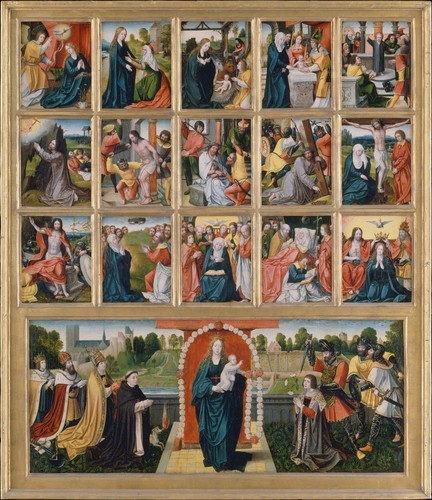
The Fifteen Mysteries and the Virgin of the Rosary by Netherlandish Painter , ca. 1515–20, European Paintings
Anonymous Bequest, 1984 Metropolitan Museum of Art, New York, NY
Medium: Oil on wood
http://www.metmuseum.org/art/collection/search/437216
5 notes
·
View notes
Photo
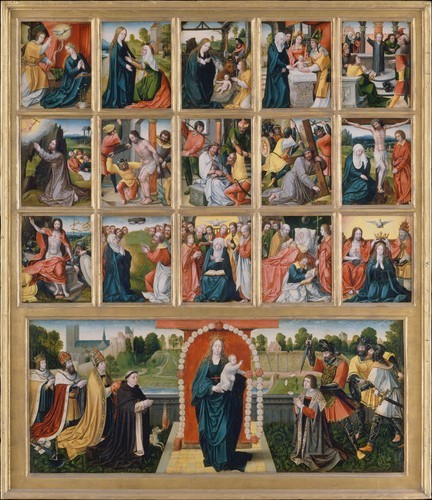
The Fifteen Mysteries and the Virgin of the Rosary by Netherlandish Painter , ca. 1515–20, European Paintings
Anonymous Bequest, 1984 Metropolitan Museum of Art, New York, NY
Medium: Oil on wood
http://www.metmuseum.org/art/collection/search/437216
8 notes
·
View notes
Photo

Master of the Mansi Magdalene - Salvator Mundi in a Landscape -
Salvator Mundi, Latin for Saviour of the World, is a subject in iconography depicting Christ with his right hand raised in blessing and his left hand holding an orb (frequently surmounted by a cross), known as a globus cruciger. The latter symbolizes the Earth, and the whole composition has strong eschatological undertones.
The theme was made popular by Northern painters such as Jan van Eyck, Hans Memling, and Albrecht Dürer. There are also several versions of the theme attributed to Titian, notably the one in the Hermitage Museum.
One painting of the subject, simply titled Salvator Mundi, was attributed or reattributed to Leonardo da Vinci in 2011. This painting disappeared from 1763 until 1900, when it was acquired from Sir Charles Robinson. It was at the time thought to be a work by Leonardo's follower, Bernardino Luini, and was purchased for the Doughty House in Richmond, London by Sir Francis Cook . By this time Christ's face and hair had been extensively repainted. A photograph taken in 1912 records the work's altered appearance. In 2017, this painting sold at auction for US$450,300,000, the highest price ever paid for a painting.
The Master of the Mansi Magdalen (c.1490 – 1530), was an Early Netherlandish painter.
In art history, a Notname, "necessity-name" or "contingency-name") is an invented name given to an artist whose identity has been lost. The practice arose from the need to give such artists and their typically untitled, or generically titled works, an acceptable if unsatisfactory grouping, avoiding confusion when cataloging. The phrases provisional name, name of convenience and emergency names are sometimes used to describe anonymous masters; nonce name was at one time used.
The practice of using generic names for unidentified artists is most common in the study of art of the antiquity, especially of the Roman era or with artists of the Northern Renaissance until about 1430. Typically a pseudonym is applied after commonality is established for a grouping of works, of which a similarity of theme, style, iconography, biblical source or physical location can probably be attributed to one individual or workshop, but because of lack of surviving documentary record, the name of that individual is lost. Groupings of works under a given notname can often be contentious; in specific cases art historians have argued that the reality may be a group or school of artists working under a common influence or commercial demand. Linking a generically titled old master with a historical person is usually a tempting and exciting prospect, and would establish an art historian's reputation.
37 notes
·
View notes
Photo
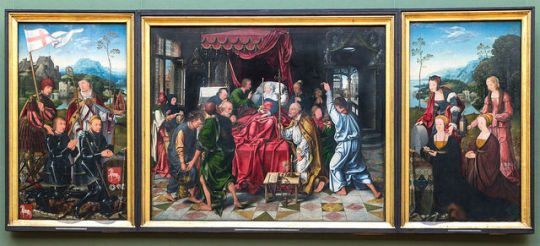
Master of the Death of the Virgin (maybe also known as Joos van Cleve) - Death of Mary - ca. 1513
Triptych with on it: Saints George and Nicasius, with the donors Nicasius and Georg Hackeney. The death of Mary. Saints Christina and Gudula, with the wives of the donors, Christina and Sybilla Hackeney.
The Death of the Virgin Mary is a common subject in Western Christian art, the equivalent of the Dormition of the Theotokos in Eastern Orthodox art. This depiction became less common as the doctrine of the Assumption gained support in the Roman Catholic Church from the Late Middle Ages onward. Although that doctrine avoids stating whether Mary was alive or dead when she was bodily taken up to Heaven, she is normally shown in art as alive. Nothing is said in the Bible about the end of Mary's life, but a tradition dating back to at least the 5th century says the twelve Apostles were miraculously assembled from their far-flung missionary activity to be present at the death, and that is the scene normally depicted, with the apostles gathered round the bed.
A virtuoso engraving by Martin Schongauer of about 1470 shows the Virgin from the foot of a large bed with the apostles spread around the three sides, and this composition influences many later depictions. Earlier depictions usually follow the standard Byzantine image, with the Virgin lying on a bed or sarcophagus across the front of the picture space, with Christ usually standing above her on the far side, and the apostles and others gathered around. Often Christ holds a small figure that may look like a baby, representing Mary's soul.
A prominent, and late, example of the subject is Death of the Virgin by Caravaggio (1606), the last major Catholic depiction. Other examples include Death of the Virgin by Andrea Mantegna and Death of the Virgin by Hugo van der Goes. All these show the gathering of the apostles around the deathbed, as does an etching by Rembrandt.
Three minor anonymous artists are known to art history as the Master of the Death of the Virgin.
A triptych (TRIP-tik; from the Greek adjective τρίπτυχον "triptukhon" ("three-fold"), from tri, i.e., "three" and ptysso, i.e., "to fold" or ptyx, i.e., "fold") is a work of art (usually a panel painting) that is divided into three sections, or three carved panels that are hinged together and can be folded shut or displayed open. It is therefore a type of polyptych, the term for all multi-panel works. The middle panel is typically the largest and it is flanked by two smaller related works, although there are triptychs of equal-sized panels. The form can also be used for pendant jewelry.
Despite its connection to an art format, the term is sometimes used more generally to connote anything with three parts, particularly if they are integrated into a single unit.
The Master of the Death of the Virgin was an Early Netherlandish painter active between 1507 and 1537. He is believed to be responsible for a large group of paintings; two of these are altarpieces of the Death of the Virgin, one in Cologne and one in Munich, from which his name is derived. He is sometimes, but not universally, identified with Joos van Cleve. Nothing further appears to be known about him.
Joos van Cleve (also Joos van der Beke; c. 1485 – 1540/1541) was a painter active in Antwerp around 1511 to 1540. He is known for combining traditional Dutch painting techniques with influences of more contemporary Renaissance painting styles.
An active member and co-deacon of the Guild of Saint Luke of Antwerp, he is known mostly for his religious works and portraits of royalty. As a skilled technician, his art shows sensitivity to color and a unique solidarity of figures. He was one of the first to introduce broad landscapes in the backgrounds of his paintings, which would become a popular technique of sixteenth century northern Renaissance paintings.
He was the father of Cornelis van Cleve (1520-1567) who also became a painter. Cornelis became mentally ill during a residence in England and was therefore referred to as 'Sotte Cleef' (mad Cleef).
17 notes
·
View notes
Photo
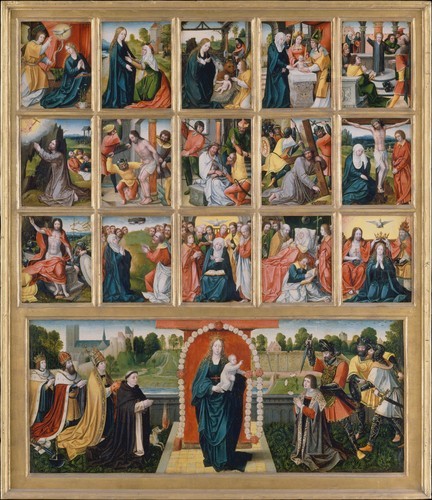
The Fifteen Mysteries and the Virgin of the Rosary by Netherlandish Painter , ca. 1515–20, European Paintings
Anonymous Bequest, 1984 Metropolitan Museum of Art, New York, NY
Medium: Oil on wood
http://www.metmuseum.org/art/collection/search/437216
19 notes
·
View notes
Photo
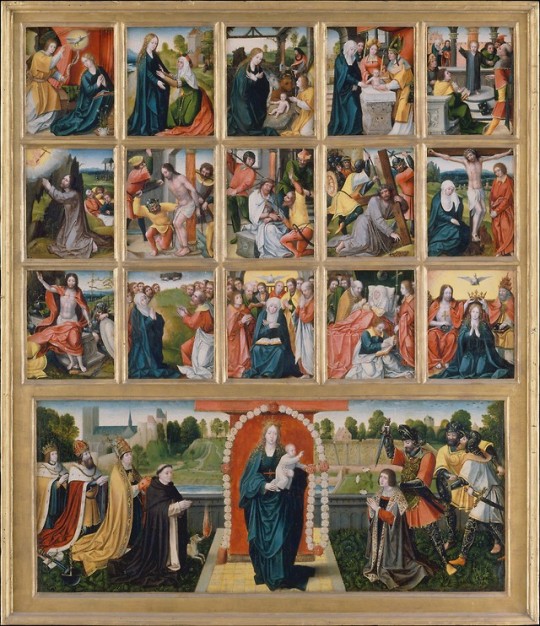
The Fifteen Mysteries and the Virgin of the Rosary by Netherlandish Painter , ca. 1515–20, European Paintings
Anonymous Bequest, 1984 Metropolitan Museum of Art, New York, NY
Medium: Oil on wood
http://www.metmuseum.org/art/collection/search/437216
108 notes
·
View notes
Photo

The Fifteen Mysteries and the Virgin of the Rosary by Netherlandish Painter , ca. 1515–20, European Paintings
Medium: Oil on wood
Anonymous Bequest, 1984 Metropolitan Museum of Art, New York, NY
http://www.metmuseum.org/art/collection/search/437216
24 notes
·
View notes